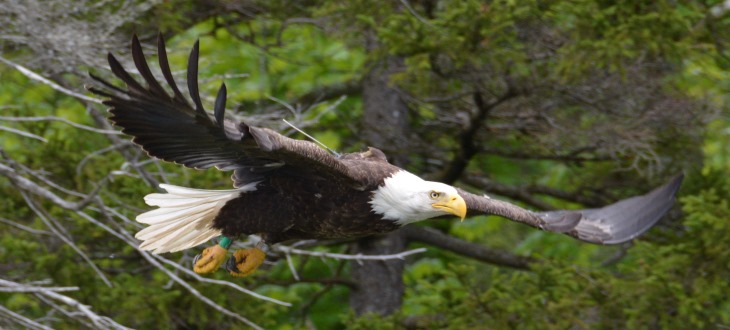The State We're In
‘Early bird’ bald eagles already nesting
Bald eagles are New Jersey’s early birds. In the chill of winter, they’re the first to build nests and lay eggs.
Even in the short days of December, these early birds are busy gathering sticks, grass and other materials to build or repair their nests. Only two weeks into the new year, they start laying eggs. The first bald eagle chicks of 2019 are expected to begin hatching later this month and in early March.
“Right now, we have about 20 pairs of bald eagles that are on their eggs and incubating them,” said Larissa Smith, biologist for the Conserve Wildlife Foundation of New Jersey and one of the leaders of the New Jersey Bald Eagle Project, which has been tracking the state’s population of these majestic birds over the past 35 years.
The NJ Bald Eagle Project, a collaboration between the New Jersey Division of Fish & Wildlife and the Conserve Wildlife Foundation of New Jersey, monitors bald eagle nests and territories to help ensure the birds’ long-term survival.
Another 160 or more bald eagle pairs are just beginning their nesting season, and will lay clutches of eggs from now through March.
Once virtually wiped out in New Jersey, bald eagles are staging an amazing recovery. During the mid-1900s, eagle populations plummeted due to use of the pesticide DDT, which caused egg shells to be too thin and fragile to be viable.
By 1970, this state we’re in was down to one single nesting pair of bald eagles. DDT was outlawed in 1972, but the recovery was slow. Ten years later, in 1982, New Jersey still had just one nesting pair. But eventually, the DDT ban, combined with restoration and management efforts by the state Division of Fish and Wildlife’s Endangered and Nongame Species Program, began to pay off.
According to the NJ Bald Eagle Project, the state’s eagle population increased to 11 pairs in 1995, 23 pairs in 2000, 48 pairs in 2005, 82 pairs in 2010, and 150 pairs in 2015.
As of the 2018 count, there were 204 pairs producing 185 nests with eggs. Perhaps because of the cold, wet spring, only two-thirds (121 nests) were successful in 2018, with 172 fledglings.
Still, says Smith, “the eagles are doing great.” Bald eagle nests have been found in every county in New Jersey except for Essex. The largest concentration of nests is found along the Delaware Bay in Salem and Cumberland counties.
The NJ Bald Eagle Project relies on a dedicated network of about 85 volunteers who monitor nest sites and look for new nests. During the bald eagle nesting season, they make weekly visits – from a distance, with powerful binoculars and spotting scopes – and log their findings into an online database.
One such volunteer is Dr. Emile DeVito, New Jersey Conservation Foundation’s staff biologist, who monitors an eagle nest at the Franklin Parker Preserve in the Pine Barrens that has been occupied every year since about 2006.
Emile visited the preserve this week and found eagles at the nest again. “One bird is sitting in the nest and the other is watching from a high branch about 50 feet away,” he said. “I think the female is probably incubating an egg or getting ready to lay one any day now.”
Emile is constantly on the lookout for new nests to add to the state’s database. Recently, one of his family members spotted a bald eagle perched atop a church steeple in South Plainfield, and another flying in the same vicinity with an animal in its talons.
“Having seen a pair of eagles, it’s likely that there’s a nest nearby, hidden in one of the flood plain forests near the Dismal Swamp, Cedar Brook or Bound Brook,” Emile said.
Want to see a bald eagle? Consider a trip to the Delaware Bay region, where eagles are frequently spotted as they hunt in the bay, rivers, lakes, marshes and reservoirs. Visit the eBird online map at https://ebird.org/nj/region/US-NJ?yr=all to see all the places where eagles have been seen recently.
You can also check out the “eagle cam” focused on a nest at Duke Farms in Hillsborough. There have been recent signs of an eagle pair sprucing up the nest, but as of the first week in February no eggs have been laid. For a live stream view of the nest, go to https://www.dukefarms.org/making-an-impact/eagle-cam/.
To read the 2018 report of the New Jersey Bald Eagle Project, go to https://www.njfishandwildlife.com/ensp/pdf/eglrpt18.pdf.
Another fun way to learn about bald eagles is through “EagleTrax,” the Conserve Wildlife Foundation’s online mapping tool that tracks the movements of two eagles outfitted with telemetry harnesses. The first, “Harmony,” is a five-year-old female hatched at the Merrill Creek Reservoir and banded in 2012. The second, “Pedro,” is a four-year-old male who was rescued last year in Pedricktown after being found injured. To see where Harmony and Pedro have been pinged, go to http://www.conservewildlifenj.org/protecting/eagle-trax/.
And for information about preserving New Jersey’s land and natural resources – including bald eagle hunting grounds and nesting sites – visit the New Jersey Conservation Foundation website at www.njconservation.org or contact me at info@njconservation.org.
About the Authors
Alison Mitchell
Co-Executive Director
John S. Watson, Jr.
Co-Executive Director
Tom Gilbert
Co-Executive Director, 2022-2023
Michele S. Byers
Executive Director, 1999-2021
View their full bios here.
Filter
Get The Latest News
From The Garden State
In the
News

